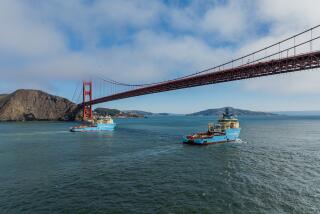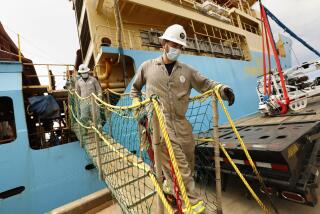Ubiquitous Plastic Fouls Sea, Takes Toll of Wildlife
- Share via
BOSTON — The oceans are choking in plastic junk that kills marine life and forms a crust on once pristine coastlines, according to a researcher who has combed the sea for five years.
Industrial abuse heaped on the oceans became vivid in reports about the devastating Exxon Valdez oil spill in Alaska’s Prince William Sound and the mysterious algae tides fouling beaches in the Mediterranean.
But less well known is that tons of long-lasting plastic debris has accumulated for years on the high seas, washing ashore on beaches thousands of miles away from where it was dumped.
Like dirty rings on a bathtub, bits of plastic coat beaches from the central Gulf Coast to Cape Cod and across the Atlantic on the western shore of England.
“I’ve found hockey pucks on beaches in the Bahamas,” oceanographer Jude Wilber said in an interview. “Mediterranean coasts are very plasticized.”
Far out in the Atlantic on a 135-foot schooner, run as an educational program for college students, Wilber found that plastic pollution is ubiquitous.
“We’ve gone from what we assume was a plastic-free ocean in 1960 to our present state,” Wilber said. “Over large parts of the ocean well removed from any shore it’s virtually impossible to tow a sample without getting some plastic.
“Roughly 30% of the Atlantic contains high concentrations of plastic,” he said. “In those areas, it is impossible to tow a net without getting something. You can find roughly 10,000 pieces per square kilometer,” which is less than half a square mile.
On dozens of voyages with student crews throughout the North Atlantic, Wilber has taken more than 1,000 samples by dragging a fine mesh bushel-sized net for a mile at a time.
He winds up his research this fall with a final cruise to the Caribbean from the Woods Hole, Mass., base of the maritime program offered to college students by the Sea Education Assn.
The plastic pollution kills fish, sea birds, turtles, seals and whales, and can damage coral in the tropics, he said.
Sea birds, including albatross and various species that never go ashore, are found stuffed with plastic beads or strangled by fishing line.
Giant sea turtles have become an endangered species, partly because so many suffocate after ingesting plastic bags mistaken for jellyfish, a favored food. Whales and seals are similarly threatened.
Coral is whisked away by snagged line whipped like a scythe by the waves.
Most of the plastic junk escapes through fishermen’s nets, but the beads of polyethylene ingested by fish and lobster is certainly undesirable from a consumer standpoint, said Robert Bryant, an expert on New England’s lobster industry at the University of Maine.
Plastic beads, the building blocks of all types of plastic goods, are manufactured in several nations and then transported by ship to be melted down and molded elsewhere. Spillage is relatively common.
Wilber’s research, since he first publicized his discoveries two years ago, has focused on the path of the debris. He has found that floating plastic circulates on ocean currents that reveal the Atlantic to be a gigantic whirlpool, centered in Bermuda.
“People make the assumption that pollution is close to shore, and it’s just not true,” he says. “The highest concentrations are in the middle of the ocean, much higher than it is adjacent to any coast.”
Plastic is long-lived and most of it does not degrade either in landfills or in the ocean, he said.
“But it’s subtle, with none of the dramatic, instantaneous effects such as you get with an oil spill or toxic waste dumping,” he said.
One disgusting result appears on the rocky coasts of Caribbean islands, Wilber said. A crust as much as half-a-foot thick, made up of tar from oil spills embedded with bits of plastic, extends over the entire windward shore of some islands.
“The tar acts a lot like plastic in that it floats around the ocean for years. Coagulated clumps of oil get caught in our nets, too, and ends up on the same shores and beaches,” Wilber said.
More to Read
Sign up for Essential California
The most important California stories and recommendations in your inbox every morning.
You may occasionally receive promotional content from the Los Angeles Times.










